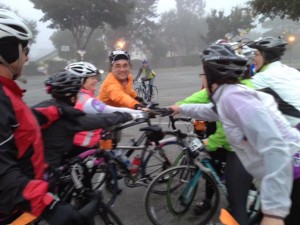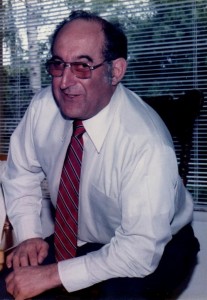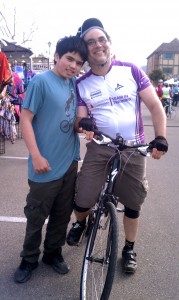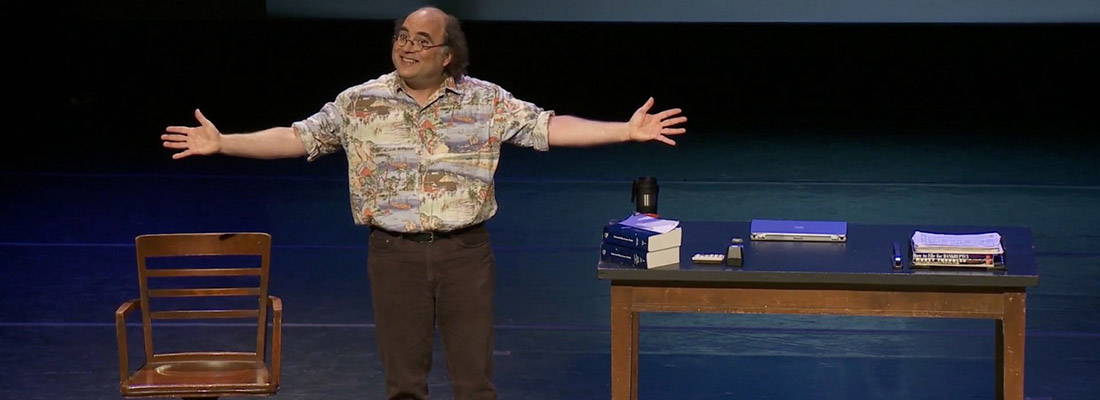
A dog was barking, furiously, as we began our 100-mile bike ride on Saturday, March 10. It was about 6:30 in the morning in Solvang, California, and my Team In Training (TNT) teammates and I were thrilled to finally be starting the Solvang Century after months of training. The dog was in a house on what I’m sure is normally a sleepy street, and it clearly considered us to be potential intruders. What it couldn’t have known was that we were only the first of thousands of riders who would be pedaling past the house that morning. I wondered whether the dog would have the stamina to keep barking until the last possible helmeted intruder, smelling of sunblock and chain lubricant, had wheeled off into the distance.
Also, I wondered — and not casually — whether I would have the stamina to make it through all 100 miles. I really, really didn’t want to fail. In the week leading up to Solvang, I’d felt nervous and restless — a condition that wasn’t helped by our coach’s strict instructions that we not do any strenuous training during that week, so that we’d be fresh for the ride. Over these months I’d gotten used to doing four days of workouts each week: core-strengthening, spinning, and stretching (including the continuation of my futile lifelong quest to touch my toes; I bet my toes feel like smooth pebbles on a balmy Mediterranean shore; I’ll never know). Without that daily endorphin rush, my essential, sedentary self threatened to wrest back control from the wannabe athlete who’d been in charge lately. Maybe, by the time we were ready to start at Solvang, I’d have completely reverted to a couch potato.

But as we continued past the barking dog, through more residential streets, and then onto a freeway, those fears mostly evaporated. Biking with my teammates had become a natural thing for me: My feet now belonged in biking shoes, clipped to the pedals, and my butt belonged on the saddle. As always, we called out potential hazards to our teammates: “Car up!” “Glass!” “Slowing!” And we thought about the people we loved — and people whom others loved, as well. It occurred to me, as we went along, that after a lifetime of obsessively thinking about and talking about my family (particularly my late father), I now was focusing, in part, on people I’d never met. For example, Alex Pezzuto. Alex died 22 years ago of chronic leukemia. I learned about him from his daughter, Mary, who is on my e-list. He was a delightful guy — accordion player, delicatessen owner, terrific dancer, loving father of six children. He had one wonky eye, and he was always joking and teasing. This is my favorite thing that Mary wrote to me about her dad:
Alex had a signature comment whenever anyone was aggravated or impatient with him. Usually it was in response to some horrifying or deeply embarrassing breach of etiquette to which he paid no attention. His response was: Love Me, Love My Dog. It always put us into stitches because it’s so ridiculous. I don’t know, maybe you had to be there. Anyhow.
“Love me, love my dog.” I thought of that phrase over and over during our training, and it helped to sustain me through the Solvang event (including when that dog, which I’m sure is very much loved, was barking at us), making me smile even during long climbs.
Of which there were several. The first ascent happened relatively early in the ride, between miles 20 and 30. It began the way so many climbs do: You’re just cycling down a hill or along a flat stretch of road, minding your own business, and suddenly … you’re going up. And up, and up. Before I started my training, I was mostly preoccupied with whether I’d be able to deal with climbs — but now, after so many Saturday sessions with my team, I knew to just go down into my easiest gear, pin my ears back, and pedal my way to the top. Inching up the incline with hundreds of other cyclists, all of us stretched out in single file along the side of the freeway, felt something like being a tiny part of a giant, wheeled millipede. Though of course, here — as throughout the event — many cyclists would, traffic permitting, speed past me. (A teammate would warn, “Biker left!” — which, for part of the ride, I daydreamed about titling a publication for progressive cyclists.) One time, a biker zipped by me, really close, and it momentarily unbalanced me: suddenly I found myself veering out into the traffic lanes (albeit incredibly slowly). (Something like this — a possible near-spill — happens to me on pretty much every ride. So far — knock wood — I haven’t actually had an accident.) I managed to unclip my left shoe in time to get my foot down on the road and prevent myself from falling — and fortunately, there were no cars coming up behind me at that moment. Within a few seconds, I was back on track, in my single file of cyclists. Voices called out: “Are you okay?”
One of the concerned voices, inevitably, belonged to my coach, the Bumpster. The Bumpster has a very distinctive voice: sweet and sharp and high. Her laugh (and she laughs quite a lot) is amazing — you can hear it from a long distance away. On this day I decided that the Bumpster’s laugh kind of resembles the call of a seagull: you know, that resonant, question-marky sound they make? In my little group (nicknamed Team Margarita, for the drink that the Bumpster likes to serve during post-ride celebrations), we always responded powerfully to the Call of the Bumpster: no matter how far we may have strayed, that laugh drew us back to the safety and solidarity of our flock. In the non-cycling part of her life, the Bumpster is an ER nurse; I would bet that her laugh has speeded many a patient back to good health.

When we got to our second SAG (refreshments) stop, my wife, Sara, and son, Guthrie, were already there waiting for me. I cannot tell you how much joy I got from having them down at Solvang to share this experience! They met me at several SAG stops, and occasionally would pull up beside me in my wife’s car as I biked along. These encounters made me feel glorious, like a participant in the Tour de France or something, only much slower and without any alleged performance-enhancers (unless you count the peanut-butter-honey-and-banana sandwiches that Sara had prepared for me). Several other teammates had friends and family members with them as well — and so did many other riders at Solvang (most of whom were not with Team In Training). As a result, especially towards the end of the ride, the vibe along the route was incredibly festive.
But before we could get to the end, we had to go up “the Wall.” Or, as it was often referred to, “the notorious Wall.” The Wall — a steady, relatively steep ascent — goes from about mile 70 to around mile 83. In fact, one of the things we’d been warned about regarding the Solvang Century was that the bulk of the climbing happens late in the ride. The thing is, a few miles before the Wall there was another ascent — one that, the Bumpster repeatedly told us, was actually harder than the Wall itself. Whether or not this was true (I have written before about the Bumpster’s propensity to lie in the service of motivation), it did make the Wall seem less daunting to me; after all, according the Bumpster, we’d already gotten through worse. Moreover, our training rides had often packed in way more climbing per mile than Solvang could throw at us. So we just downshifted, pinned our ears back, and kept going.
As often happens, the toughest ascent — psychologically, at least — came when many of us assumed we’d already gotten all the hard climbing out of the way. In this case, it was a section (around the 90-mile mark) that the Bumpster had (from her previous experiences at Solvang) nicknamed “Little Bitch.” Somehow, Little Bitch isn’t officially counted by the ride organizers as a hill — but believe me, it’s a hill! And a twisty one, at that. On previous ascents, I’d swallowed a packet of caffeinated energy goop to help propel me. But by this point in the ride, I was over the whole eating thing — especially sweet stuff; I just couldn’t deal with it anymore. Normally among the most avid eaters of peanut-butter-and-anything-sandwiches, I gazed upon the ubiquitous PB&J’s at our later SAG stops with utter disinterest. Like a camel that had learned to depend on its hump, I felt a serene certainty that my body contained sufficient stores to power me the rest of the way. Plus, I was the opposite of hungry: I felt like a nation that had suddenly gone from being a net importer of energy to an exporter.
Also, I felt hot. Throughout our training sessions during the Bay Area winter, it had always been relatively cool — sometimes, downright frigid. Down here in SoCal, the chilly morning had given way to a scorching afternoon. Anticipating this, I had, the previous week, bought a kind of skullcap designed to go under my helmet and protect my bald head from the kind of airhole-pattern burn-striping that had inspired my team to nickname me “Manimal.” I found it ironic that I was now biking while wearing a skullcap, as this reminded me of all the Saturday mornings that my cycling training had kept me from going to synagogue. (I have kind of a passive-aggressive relationship with God — though, to be fair, God started it.) What I hadn’t anticipated was that, for the very first time in my relatively short endurance-cycling experience, today it would become so hot that I’d be moved to take off the arm-warmers I’d worn on every training ride. As a result of this (and of my lack of sunblock), my arms became so burnt that — even now as I write this, nine days after the event — they are peeling like the skin of a horror-movie creature. Which, of course, makes me very proud.

The last few miles of the Solvang Century were all downhill or flat, and my teammates and I enjoyed them immensely. Guthrie and Sara were cheering by the side of the road as we neared the finish line — one of the peak moments of my day, and of my life. A bunch of us actually cycled past the finish line — causing the Bumpster to yell out to us, penetratingly, to circle back. But even though we’d covered that extra bit of distance, at the end of the ride my bike’s little computer thingie told me that we’d gone only 98.5 miles.
This wouldn’t do! After picking up my way-cool Solvang Century completer’s medallion and pin at the TNT booth, I continued biking to a nearby parking lot. And there, with my son jogging along beside me, I cycled an additional 1.5 miles — until I had officially made it through 100 miles. At which point, I finally got off my bike, and Guthrie, Sara, and I wandered around Solvang in search of some celebratory aebleskivers. Aebleskivers are said to be the supreme delicacy in Solvang, which is kind of a Disneyfied replica of a Danish town. Well, we finally found a place where we could buy aebleskivers. Let me tell you two things about the aebleskivers we ate:
- They tasted like blobs of deep-fried dough immersed in cherry cough syrup.
- I thought they were delicious.

(From some Googling, I’ve learned that apparently the correct plural is not “aebleskivers” but “aebleskiver.” I will not, however, allow the Danes to exercise their usual linguistic hegemony in this important matter.)
After the ride, there was a celebration dinner at a nearby hotel for TNT riders and their entourages. The food was terrible; I had three helpings. My hunger, briefly dormant for those last few miles of the century, had returned — with a vengeance. The Bumpster came by my table to serve me one of her homemade margaritas; it was the very stuff that dreams are made of.
The next morning, we hooked my bike onto the back of Sara’s car and headed back up to Berkeley. It was poignant to say goodbye to my teammates, and it felt weird to have already completed the event, after all those months of training and worrying and wondering. I don’t deal well with finishing things; it took me over a week to bring myself to do this little blog entry about Solvang, as if writing about it would seal the whole experience into an inaccessible past. I worked really hard to prepare for my first century ride, and then I actually did it — which, me being me, I find somewhat depressing. I’m a lot more comfortable with incompletion, even more so with failure. I realize that this is creepy and wrong, but really, there’s nothing to be done about it. You know: Love me, love my dog.
Again, let me offer my infinite thanks to everyone who contributed the Leukemia & Lymphoma Society in support of my ride! You have helped to fight blood cancer, and to make life better for cancer patients and their loved ones. People who want to donate still can, through April 9, by clicking here.
Below is a map of my Solvang Century ride; you can click on it to get details regarding speed, heart rate, elevation, and more (though strangely, it contains no sunburn-related data).

Congratulations Josh! I really enjoyed reading about your ride as I missed seeing you on the road and at the celebration dinner. Thank you for being on our team – it was truly a gift to all of us. Hugs, K.Sue
Thank you, K.Sue! You were an awesome head coach!!
Josh, your humor and singing during the century helped members of your team persevere. Your compassion for those of us you ride for is wonderful. GO TEAM
Thanks so much, Jim — and thanks, also, for your world-class SAG-stop offerings!!
Josh, first of all heartiest congratulations with completion of the ride. Next stop, Solvang Autumn Double Century (http://www.planetultra.com/SolvangFall/index.html). Really, since you’re brimming with fitness and confidence, you should have ridden the Spring Double, which was two days ago.
Congratulations Josh. What a fabulous accomplishment. Not only your ride but the success in raising so much more money than your goal. This granny is very proud of you.